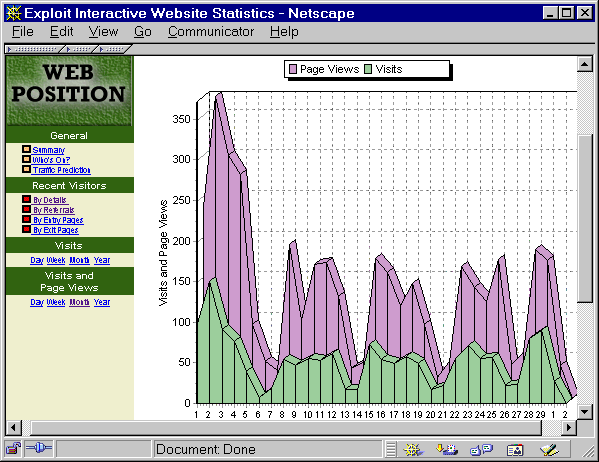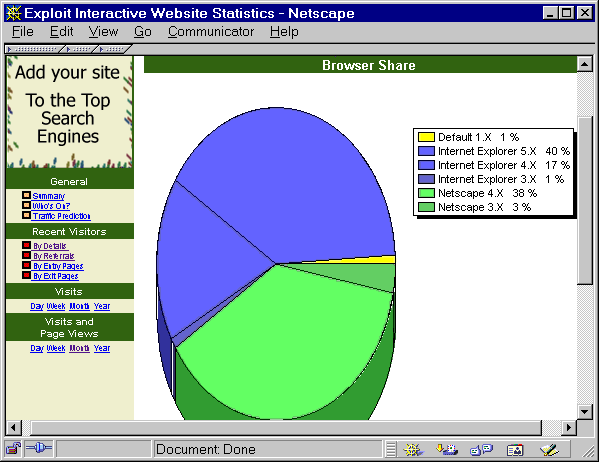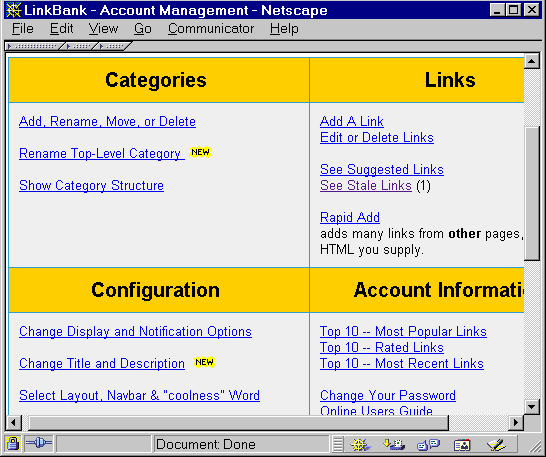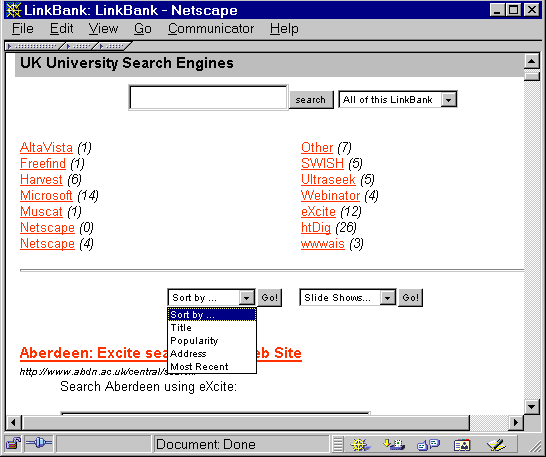Web Focus: The Use of Third-Party Web Services
Background
University web managers are busy people. University departments seem to have never-ending requirements for new services on the institutional web site. But, as we all know, it can be difficult to get the funding to buy expensive software products or extra staff to install and support free software.
But is there an alternative approach to trying to do everything in-house? Nowadays the Web provides not only access to information resources, but also to applications. Might not the use of externally-hosted applications across the Web provide a cost-effective answer for University web teams?
Externally-Hosted Web Services
Let us first look at some of the externally-hosted services which are available on the Web.
Web Statistics
Most people are interested in web statistics. The statistics may be needed to justify the expense of the service, to monitor where the visitors are coming from, to investigate how the web site is being used or to detect broken links or other problems with the web site.
But it can be difficult to provide access to web statistics to a range of information providers. The software must be purchased - although software such as Analog is freely available, there is a cost associated with software which provides richer functionality. Once the software has been purchased and installed, effort must be spend in configuring the web server and managing the log files. Although this can, and should, be automated, it may be difficult to allow, say, departmental information providers to carry out data mining of their data. These difficulties can be compounded for departmental or project web sites, which may not have dedicated IT support.
A number of externally-hosted services for providing web statistics are available, including NedStat [1], SiteMeter [2], SuperStats [3] and Stats4All [4].
These service typically work by providing a small icon which is included on pages on the web site. When a visitor accesses a page containing the icon, a request for the image is sent to the company hosting the service. The request is logged. The log file may store not only the date and time of the request, but also a variety of additional information, such as the referrer field (how did the visitor get to the page), the search engine query string (if the visitor used a search engine to get to the page, what search term did they enter), a profile of the visitors client machine (operating system, browser, screen resolution, etc).
The Exploit Interactive web magazine [5] is currently evaluating the services provided by NedStat and SiteMeter and a report will be published in Exploit Interactive shortly.
Arguably one of the advantages of externally-hosted web statistical analysis services is the ease of access to the reports. Typical clicking an icon (such as this ) will provide access to the information. The Exploit Interactive statistics provided by SiteMeter are freely available [6] and examples of the reports are shown below.
Figure 1 gives graphical representation of the numbers of page views and visits during February 2000.

Figure 1: Numbers of page views and visits in February 2000
Figure 2 shows the browsers and browser versions which have accessed the web site.

Figure 2: Pie chart of the browsers and browser versions which have accessed the web site
An example of NedStat can be see at the Information Research e-journal web site [7]. This web site has been using the service since 1 April 1998, so it provides useful information on long-term trends.
Link Management
All University web sites provide links to external Web service, as reported in Ariadne issue 22 [8]. Maintainers (and, indeed, users) of large-scale link gateways (as such resources are sometime called) are aware of the problems in maintaining sets of links which are stored in unstructured HTML pages. However making use of link management software can be expensive or require scarce software installation expertise.
As with web statistics software, management of web gateways can be provided by use of services on the Web. LinkBank [9] and HotLinks [10] are examples of this type of service. LinkBank provides a forms-based interface for uploading link information (with a bulk-upload facility). An example of the administrators interface is shown below.

Figure 3: LinkBank Administrator’s Interface
The information provider receives automated messages when a resource is no longer available. Unavailable resources are automatically moved from public view to a review area, until the information provider has updated the link or deleted the resource.
The end user is provided with richer functionality than that provided by a static HTML resource (e.g. sorting of links, display of most popular links, rolling displays of resources, etc.), as illustrated below.

Figure 4: User’s View of LinkBank
The LinkBank shown above is used to main a gateway to UK UNiversity web sites, search engines and web gateways [11].
Indexing Services
The UK Higher Education community makes extensive use of freely-available indexing software such as ht://Dig, as documented in a recent survey [12]. But the survey also indicated that a significant minority appeared to provide no search facility on their web site.
Three institutions make use of externally-hosted indexing services for providing a search facility on their web site. St Mary’s College [13] and Northampton [14] use FreeFind and Derby University [15] make use of the AltaVista service.
It is perhaps surprising that institutions which do not currently have a search facility have not chosen to provide one and, if the technical expertise to install software such as ht://Dig is not available, have not chosen a externally-hosted indexing solution, which requires completing a form and adding a few lines of HTML, as illustrated below:
User Feedback
The Web was originally designed to provide collaborative and co-authoring services for the Particle Physics community. Unfortunately when the Web first began to grow in size and usage it was used as a publication service, with small numbers of authors and many readers. There are now many collaborative software products available. A variety of externally-hosted services for providing user feedback are available, including voting systems and real-time and asynchronous chat systems. A number of popular web sites provide simple voting systems using a service provided by EZpolls.com [16]. As can be seen the free version of the EZpolls.com is funded by advertising. A licensed version of the software is available which displays the voting form without any adverts. Another example of a web-based user feedback system based on a voting system is provided by OnlineOpinion [17]. An example of a web-based user discussion for is provided by BoardServer [18]. |
Other Services
A variety of other services can be provided by third-parties. These include authoring and validation services (such as the W3C’s HTML and CSS validation services [19] and [20]), and services for monitoring web servers [21].
Possible Barriers
Externally-hosted services can provide a cheap (often free) solution for a range of requirements. But what are the problems with use of such services? Several potential problem areas can be identified:
- Bandwidth Issues
- Many, but not all, of the services mentioned in this article are hosted in the US. Significant use of the services would increase network traffic to the US, which would not only be slower than locally-based services, but, due to the costing model for network traffic to the US, could also potentially be costly for institutions using these services.
- JANET AUP
- Use of services which provide adverts may contravene the JANET Acceptable Use Policy.
- Limited Functionality of Services
- The services may not provide the full functionality which would be provided by use of an application installed locally.
- Closed Nature of Services
- The services may not provide access to the data to be exported for reuse.
- Failure to Exploit Local Expertise
- Use of externally-hosted services may fail to make effective use of expertise available locally.
- Gives Negative Image
- Use of externally-hosted services may give the impression that the institution does not have the expertise to provide a solution locally.
- Poor User Interface
- The user interface may not integrate with the user interface of the local service.
Are The Barriers Insurmountable?
Do the problem areas mentioned above automatically rule out deployment of externally-hosted web services? Some counter arguments may be given.
- Bandwidth Issues
- In the longer term the bandwidth concerns are likely to disappear. In the medium term it would be possible for externally-hosted services to be located “closer” (in network terms) to the JANET network, thus removing the network bottle-neck.
- JANET AUP
- One could choose to subscribe the the licensed service, which does not carry adverts or use services for which access to adverts required the user to actively follow a link. In the longer term the conditions of the JANET Acceptable Use Policy could be revisited.
- Limited Functionality of Services
- The additional functionality may not be needed, or not needed at the price it would cost to provide it.
- Closed Nature of Services
- Some services do allow the data to be exported in a number of formats for reuse.
- Failure to Exploit Local Expertise
- Use of externally-hosted services will free expertise available locally to take on other tasks.
- Gives Negative Image
- Use of externally-hosted services should demonstrate that the institution is using local expertise efficiently.
- Poor User Interface
- The user interface may be more manageable if it is contained within a frame on the local site. Although many web managers do not use frames because of several well-documented problems, new developments (such as Cascading Style Sheets) should make it possible in future to provide frame-like interfaces in a more robust manner. In addition, providers of externally-hosted services are increasingly providing the option to tailor the look and feel of their services, so that it can make use of an institutional design scheme.
The UK HE Perspective
This article has mentioned a number of externally-hosted web services which may have a role to play in enhancing the services provided on UK University web sites. It should be mentioned that there are also a number of factors of particular relevance to the UK HE community.
The UK HE community has benefited greatly from its coordinated development of national services. CHEST (the Combined Higher Education Software Team) [22] provide an valuable service in negotiating deals for the HE community. Although they initially focussed on deals for software (as can be seen from their name) they now have wider interests, which includes, for example, purchase of datasets. Perhaps CHEST could use their negotiating skills to obtain a good deal for the licensed services which a number of the organisations mentioned in this article provide.
A concern for many will be whether use of free externally-hosted services which are funded by advertising revenue would contravene the JANET AUP [23]. There has been recently been discussion of the role of advertising on network services which make us of the JANET network. Some argue that the community would benefit from the cost-savings which would be gained in generating advertising revenue by providing advertisements on institutional web sites, JISC services, etc. Others are concerned that this would detract from the academic content and would reduce the amount of productive time spent by staff and students at a PC. This debate is likely to continue.
Finally it should be pointed out that the DNER (Distributed National Electronic Resource), which aims to provide seamless access to a variety of national electronic resources, will be providing services to the UK HE community which will be integrated into an institutional web site - at a level other than hypertext links! Many of the issues associated with use of commercial third-party services will be relevant to use of DNER services (perhaps even the advertising issue if JISC services are asked to go down this route).
Conclusions
To conclude many externally-hosted web services are available which can help University webmasters. There are pros and cons associated with their use, which webmasters need to take into account if they wish to add such services to the tools they use.
Institutional webmasters should remember, of course, that the devolved environment provided by the Web means that centralised approval for a strategy is not required, and there is nothing to stop departmental information providers from introducing such services for themselves. As Tom Wilson, Research Professor in Information Management in the Department of Information Studies, University of Sheffield said in a message to the author:
I use the external services because the University doesn’t allow me access to install on the server and because it doesn’t make any appropriate tools available.
I find the search engine … useful, in that it gives me data on the ‘hot topics’ - of course people use the engine as though it was searching the Web, so I get some weird requests! However, by and large it serves its purpose for me and, evidently, for the readers.
I use the counters to give me and the authors counts on hits on their papers, mainly - the counter on the top page is a reasonably good measure of use and the counter service provides some nicely outputted results, as you’ve probably seen. You may also have seen that I’ve used three counter services on the site - NedStat which gives the top page results (and some others), what used to be LinkExchange (now bcentral, owned by Microsoft) for most of the pages, and (because the LE counters have been very variable recently), I’ve just started using a counter service from MyComputer.com - which is a nice clear one and which I may continue to use in the future.
I leave the final word to Ian Usher, the Webmonger for the Department of Geography web site at UCL. Ian has used several externally hosted services and, on a recent discussion on the web-support Mailbase list [24] said:
Our search facility is currently hosted by atomz.com , some calendering by Yahoo!, so I’m increasingly drawn to externally hosted solutions… more time to catch up on other, more pressing work, until they all stop working.
References
- Nedstat
http://uk.nedstat.net/ - SiteMeter
http://www.sitemeter.com/ - Superstats
http://v2.superstats.com/ - Stats4All
http://www.stats4all.com/ - Exploit Interactive
http://www.exploit-lib.org/ - Exploit Interactive Website Statistics, SiteMeter
http://sm2.sitemeter.com/stats.asp?site=sm2-exploit-home - Information Research, University of Sheffield
http://www.shef.ac.uk/~is/publications/infres/ircont.html - WebWatch: A Survey Of Institutional Web Gateways, Ariadne issue 22
http://www.ariadne.ac.uk/issue22/web-watch/ - LinkBank
http://www.linkbank.net/ - HotLinks
http://www.hotlinks.com/ - WebWatch Links, LinkBank
http://www.linkbank.net/get_links/default/ariadne/1/ - Survey Of UK HE Institutional Search Engines - January 2000, UKOLN
http://www.ukoln.ac.uk/web-focus/surveys/uk-he-search-engines/survey-jan2000.html - Search, St Mary’s College
http://www.smuc.ac.uk/search/ - Central Search, University College, Northampton
http://www.nene.ac.uk/websearch/search.html - Central Search, University of Derby
http://www.derby.ac.uk/homepage/search.html - EZPolls
http://ezpolls.mycomputer.com/ - OnlineOpinion
http://www.o-pinion.com/ - BoardServer
http://boardserver.mycomputer.com/ - HTML Validation Service, W3C
http://validator.w3.org/ - CSS Validation Service, W3C
http://jigsaw.w3.org/css-validator/ - WatchDog
http://watchdog.mycomputer.com/ - CHEST
http://www.chest.ac.uk/ - JANET AUP, UKERNA
http://www.ja.net/documents/use.html - web-support, Posting to Mailbase list, 11 Jan 2000
http://www.mailbase.ac.uk/lists/web-support/2000-01/0005.html
Author Details
 Brian Kelly
Brian Kelly
UK Web Focus
UKOLN
University of Bath
Bath
BA2 7AY
Email: b.kelly@ukoln.ac.uk
Brian Kelly is UK Web Focus. He works for UKOLN, which is based at the University of Bath
